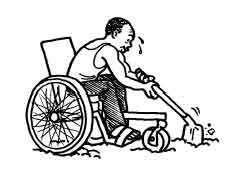Your progress
0%
Here are some of the key ideas you and your staff need to know about assistive devices.
Use your mouse or keyboard to expand each of the headings below.
Assistive devices range from simple, low-technology devices, such as walking sticks or adapted cups, to complex, high-technology devices, such as specialized computer software and hardware, or motorized wheelchairs. It is helpful to consider this wide variety of assistive devices under different categories.

The day Mosua Islam received a tricycle was “the happiest day of my life”.Learn More
Mobility devices assist people to walk or move and may include:
These may have specialized features to accommodate the needs of the user. For example, a person with cerebral palsy may require a wheelchair with trunk and head supports to ensure he or she is able to maintain a good sitting position.
The WHO guidelines on Provision of manual wheelchairs in less resourced settings are a useful reference for those people involved in the design, production and distribution of wheelchairs.
Positioning devices. People with physical impairments often have difficulty maintaining good lying, standing or sitting positions for functional activities, and are at risk of developing deformities due to improper positioning. Devices like wedges, chairs or standing frames can help overcome some of these difficulties.
These are usually custom-made devices which replace, support or correct body parts. They are designed, manufactured and fitted in specialized workshops or centres by trained prosthetic/orthotics personnel and include:
Daily living devices. These devices enable people with disabilities to carry out the activities of daily living, such as eating, bathing, dressing, toileting and home maintenance. There are many examples of these devices, including adapted cutlery and cups, shower seats and stools, toilet seats and frames, commodes and dressing sticks.
Low vision or blindness has a great impact on a person’s ability to carry out important life activities. A range of vision devices (simple to complex) can be used to maximize participation and independence, including:
Hearing loss affects a person’s ability to communicate and interact with others;
Hearing devices include:
Augmentative and alternative communication devices can assist individuals who have difficulty understanding and producing speech. Communication devices are provided to support speech (augmentative), or to compensate for speech (alternative). Devices include:
Cognition is the ability to understand and process information. It refers to the mental functions, such as memory, planning and problem-solving. Brain injuries, intellectual impairment, dementia and mental illness are some of the many conditions that may affect an individual’s cognitive ability.
The following cognitive devices can assist individuals to remember important tasks or events, manage their time and prepare for activities:

“Appropriate technology” is designed with consideration given to the environmental, cultural, social and economic factors that influence communities and individuals.
Appropriate technology meets people’s needs; it uses local skills, tools and materials and is simple, effective, affordable and acceptable to its users. Assistive devices are technologies that must be carefully designed, produced and selected to ensure they meet these criteria.
Learn about the simple change an Indian CBR programme made to the sandals being provided to people with leprosy to ensure that the sandals would actually be used.


The Assisi Leprosy and CBR in Andhra Pradesh, India provided sandals made of black microcellular rubber to people with leprosy who had lost sensation in their feet and were at risk of foot ulcers.
At one point, it became obvious that many people who were provided with these sandals did not use them. After talking with these people, it was discovered that wearing the sandals subjected them to social stigma – the black sandals had become easily identifiable in the community as shoes that only people with leprosy wore. As a result, the programme decided to use sandals available from the local market, modifying them as necessary to suit the requirements of people with leprosy.
People began wearing the footwear as there was little visible difference between their sandals and those that other community members wore.
Assessment
Assistive devices need to be carefully selected, and often need to be specially made and fitted to ensure they meet the individual’s needs. Poor selection and design can lead to many problems including frustration, discomfort and the development of secondary conditions.
Comprehensive assessment is necessary to ensure that assistive devices meet the needs of individuals within their homes, schools and work and community environments. A comprehensive assessment might include a medical history, a review of current function and individual goals, an evaluation of existing assistive devices and a physical examination.
The approach to assessment should be multidisciplinary where possible, and include a wide variety of people, such as people with disabilities, family members, therapists, technicians, teachers and CBR personnel.
Barrier-free environments
Many people use their assistive devices in various places, and it is important to ensure that all environments are barrier-free in order for someone to achieve maximum function and independence. For example, a young woman using a wheelchair must be able to use it to:
Adaptations and modifications to the physical environment include:
It is also important to consider other aspects of the environment, such as attitudes and support systems, which can also influence a person’s ability to use the device.
When considering environmental modifications, particularly within the community, it is helpful to consider “universal design.”
See what CBR in Viet Nam did to remove a barrier for wheelchair users.


In a village in the Thai Binh district of Viet Nam, CBR volunteers motivated community members to improve the local bridge so that people using wheelchairs as well as others could pass over it comfortably.